Here is another of my recipe versions for the popular and tasty Madras Mixture, which is basically a snack dish made of a medley of various ingredients, dry fruits/nuts, seasonings and spices. Though you might find a little hesitant towards this Mixture Recipe by looking at the number of steps in the methodology, but trust me, it is going to be totally worth once you prepare it. So, just go for it! Because serving the homemade version of this snack mixture during Diwali, will also just brighten the already lit festivities.

Table of Contents
More on Mixture Recipe
What is commonly known as Chivda in the northern and western parts of India, is the Mixture in southern India. And just like there are many varieties of a chivda recipe, similar is the case with a Mixture Recipe too.
In this post, I have shared the popular and loved South Indian Mixture, popular from Madras (Chennai). Two of the main ingredients of this one is omapodi (plain sev) and boondi.
Other than these, there are some nuts, poha (aval), chana dal, curry leaves, spices and seasonings. You can even add fried coconut. But I usually don’t add as it reduced the shelf-life of this particular snack.
So basically, if you have the boondi and omapodi ready from before, you just have to fry the other ingredients and mix all of them together with the spices and salt.
But in case if you don’t have the plain sev and boondi ready, look nowhere else, as my Mixture Recipe mentions the step-by-step pictorial representation of making these as well.

Some variations of the South Indian Mixture even have sweet maida (all-purpose flour) biscuits too added in them. However, I like it to keep it simple and authentic. Hence, haven’t added in my recipe.
The preparation including the making of the 2 main elements of this Madras Mixture Recipe, does take time. So, you can plan ahead and make accordingly.
Just like I made the omapodi and boondi a day before to reduce the prep work, you can also keep these ready, a day prior. This will definitely reduce the time to complete your Mixture Recipe the next day.
Why this recipe works
In this Madras Mixture recipe post, I have mentioned the methods of preparing both the omapodi and boondi. For an exclusive detailed post on both these, you can check this Omapodi Recipe and Kara Boondi Recipe.
It is always better to prepare your own snacks, especially the fried ones like this Madras Mixture Recipe, at home. By doing so, you are ensuring that the recipes are getting done using the best of ingredients and also the oil which is used to fry, isn’t reused many times.
Thus, homemade chivda and mixtures are healthier too, and will always taste a notch higher as compared to the store-bought ones.
In this South Indian Mixture too, you can also add more like Ribbon Pakoda, Thattai, Murukku and even Karasev. Just break these into smaller pieces and toss in with other ingredients.
This Madras Mixture Recipe yields about 350 grams of the yummy, crunchy-munchy snack. You can relish it with friends and family during tea-time or make it a part of your Diwali or any other festival celebrations as well. For storing, pack in air-tight jars and keep.
How to Make Mixture Recipe
Make Omapodi Dough
1. Heat a small pan and keep the heat to low. Add 1 teaspoon carom seeds (ajwain).

2. Stirring often, roast carom seeds for some seconds or till they are fragrant. No need to brown them. Let them cool.
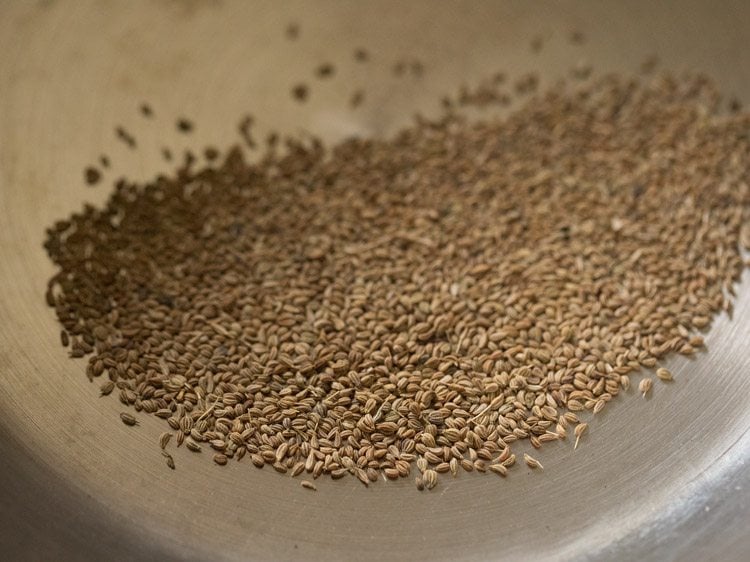
3. Then, add them in a small dry grinder jar or a spice grinder.
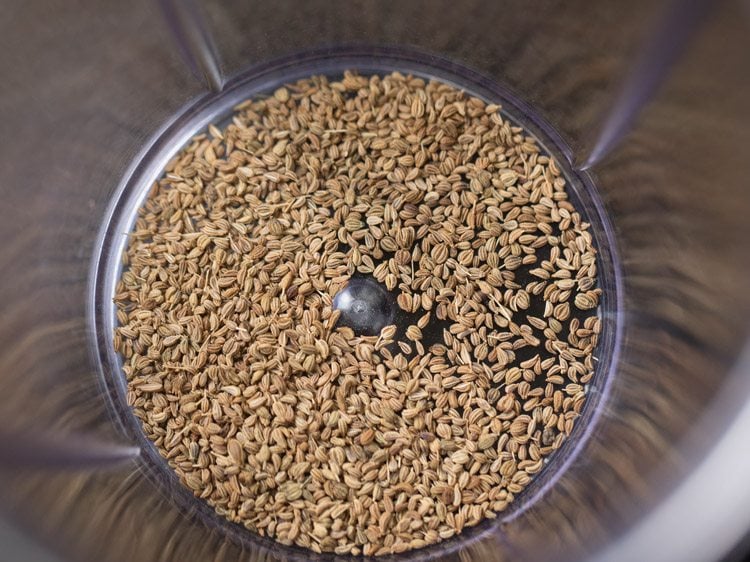
4. Grind to a fine powder. Keep aside. You can even crush ajwain in a mortar-pestle. In this case, when adding ajwain, use a tea strainer and sift the ajwain powder through it.
This is done so that when pressing through the sev maker, the dough strands do not break.
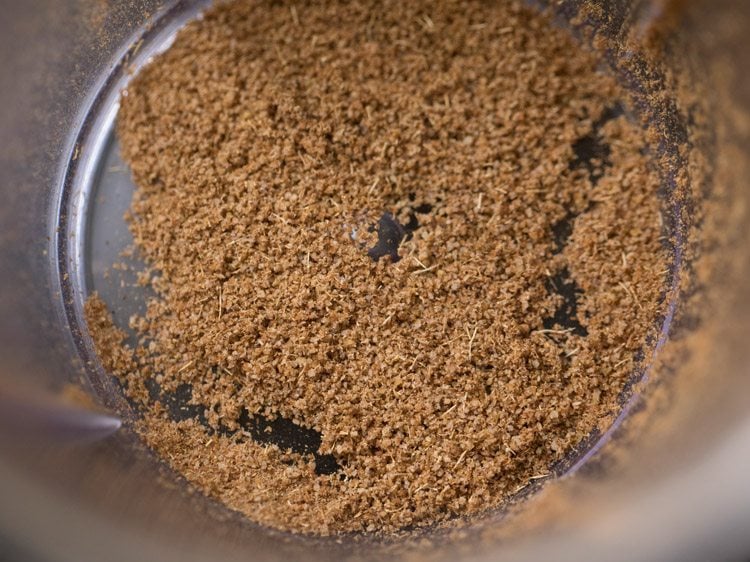
5. In a mixing bowl or pan, take 1 cup gram flour (besan) and ½ cup rice flour.
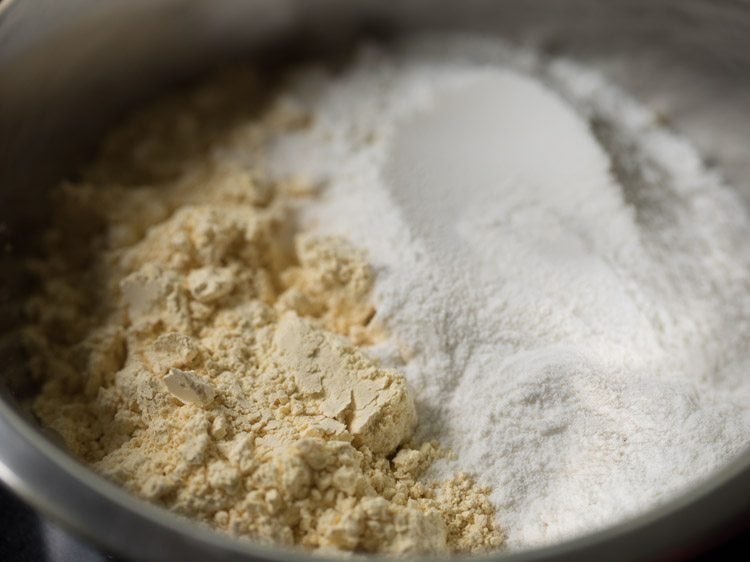
6. Add the prepared carom seeds powder.

7. Then, add 1 generous pinch asafoetida (hing), 2 pinches turmeric powder, ¼ teaspoon red chili powder and 1 teaspoon salt. You can add salt as per taste.
Turmeric powder can be skipped. For a spicy omapodi, you can increase the amount of red chili powder. For more crispiness, you can add a pinch of baking soda also.
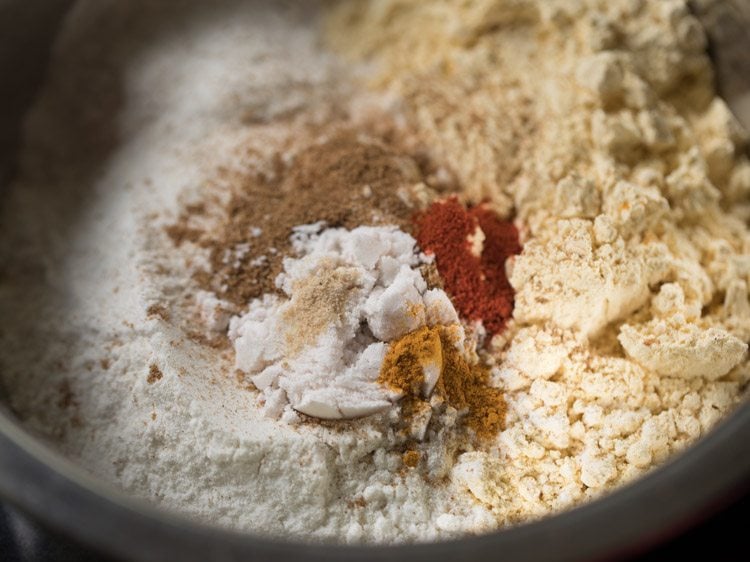
8. Mix very well with a spoon or spatula.

9. Now, heat 1 tablespoon oil in a steel bowl or a steel measuring cup.
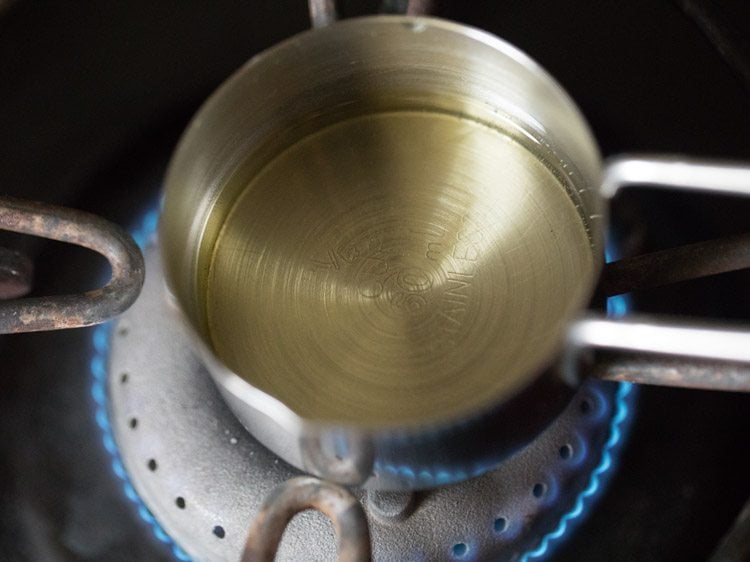
10. When the oil becomes hot, add it to the flour mixture. Instead of oil, you can also use ghee or butter.

11. With a spoon, mix the oil with the flour mixture.
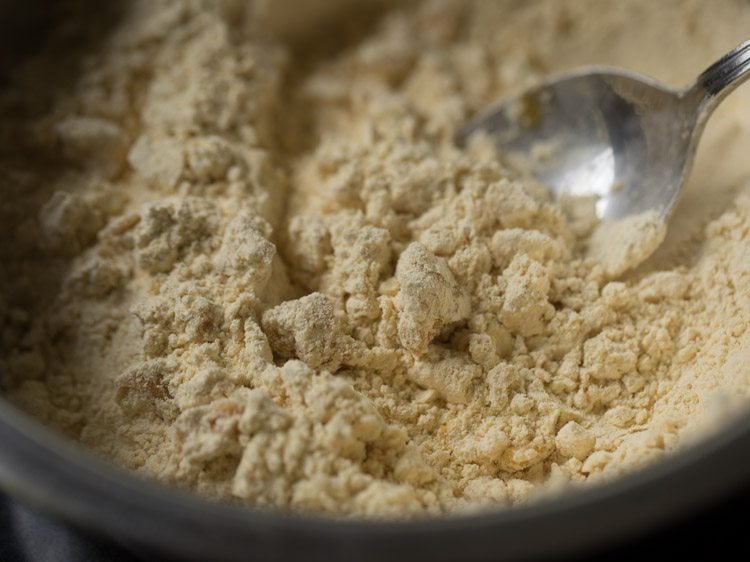
12. Now, add water in parts. First, add 2 to 3 tablespoons water. Mix well and begin to knead to a smooth dough.
I used 7 tablespoons water overall. You can add 6 to 7 tablespoons water, depending on the quality of gram flour and rice flour.

13. Knead to a smooth dough. If the dough becomes sticky, then you can add some more besan. If the dough looks dry, then add some more water and knead again. Cover the bowl.

14. Use the disc shown in the picture below, for preparing omapodi. You can even use the disc with fine holes. Also, heat a kadai and add oil as required for deep frying omapodi.
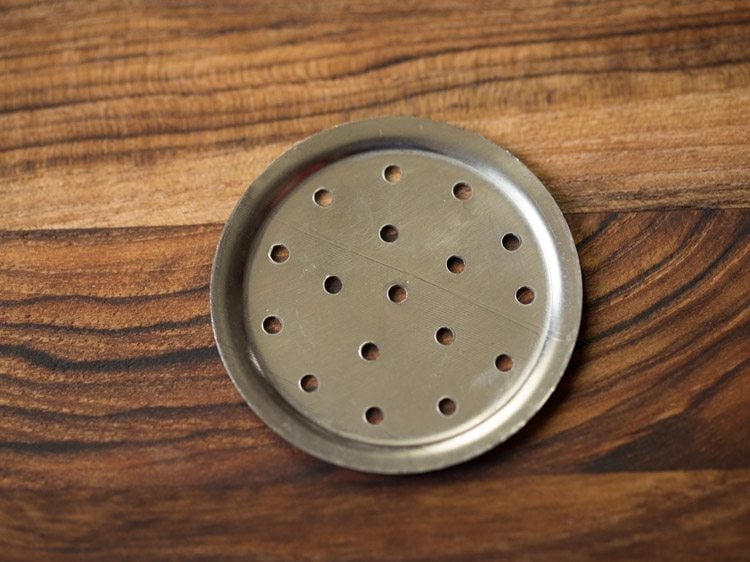
15. Apply some water or oil in the sev/murukku maker. Then, take a portion of the omapodi dough and place it inside the sev maker. Cover with the top part and keep aside.
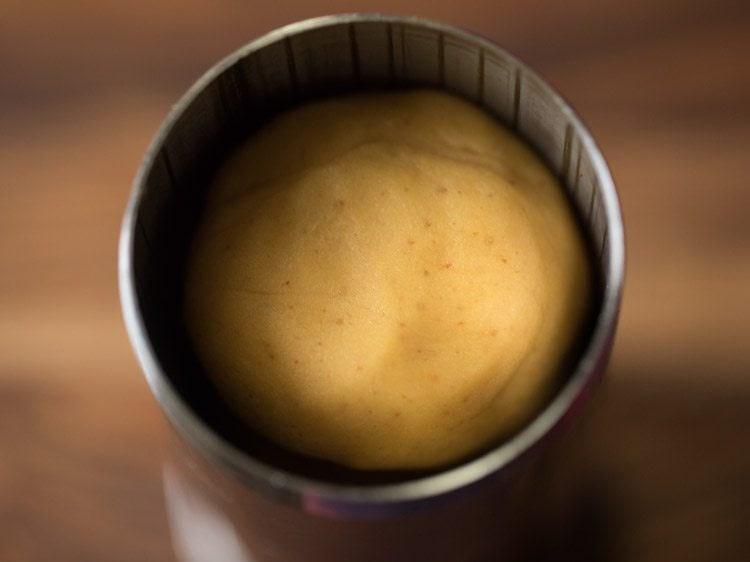
Fry Omapodi
16. Let the oil in the kadai become medium hot. Check the oil temperature by adding a tiny piece of the dough. If the small piece comes up gradually and steadily on top, the oil is hot enough to fry.
In case it comes up too quickly, then oil is too hot. If it settles down at bottom of kadai or comes up very slowly, the oil is not hot enough for frying.

17. When the oil is hot enough, directly press holding the sev maker on top of the oil and let the omapodi directly fall in the oil.
While pressing, rotate in a concentric circle from the center to outwards similar to making a Chakli.
Do not over crowd the kadai with omapodi. Be careful when pressing the omapodi in the oil.
After it is is pressed in the oil, break the top strands with a spoon or knife and let the strands fall in the oil.
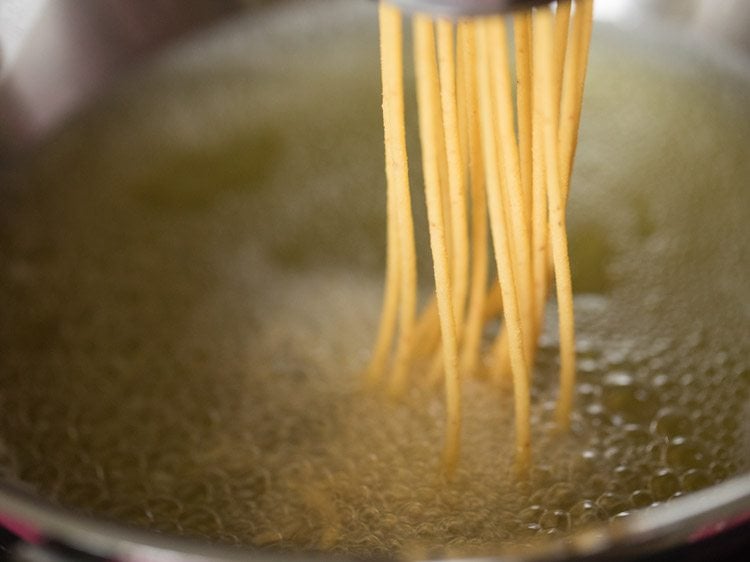
18. After adding the omapodi, do not touch immediately with the slotted spoon as they will break. Let them get fried first for a minute.
They need to become crisp first and then you can turn them over with the slotted spoon.
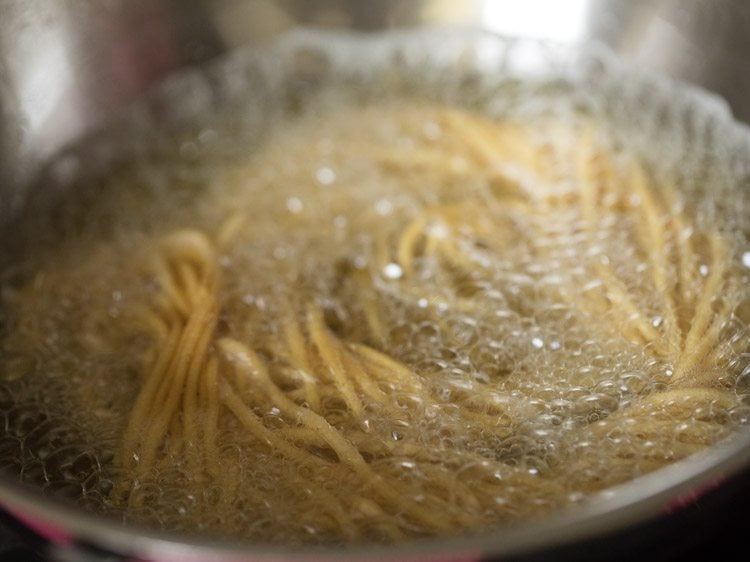
19. Gently begin to turn with a slotted spoon.
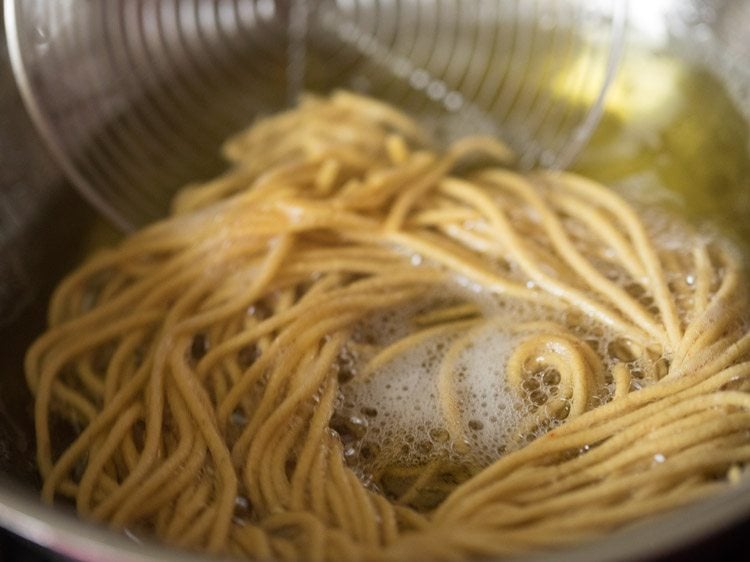
20. Now, fry the second side. You can turn over a couple of times for even frying.
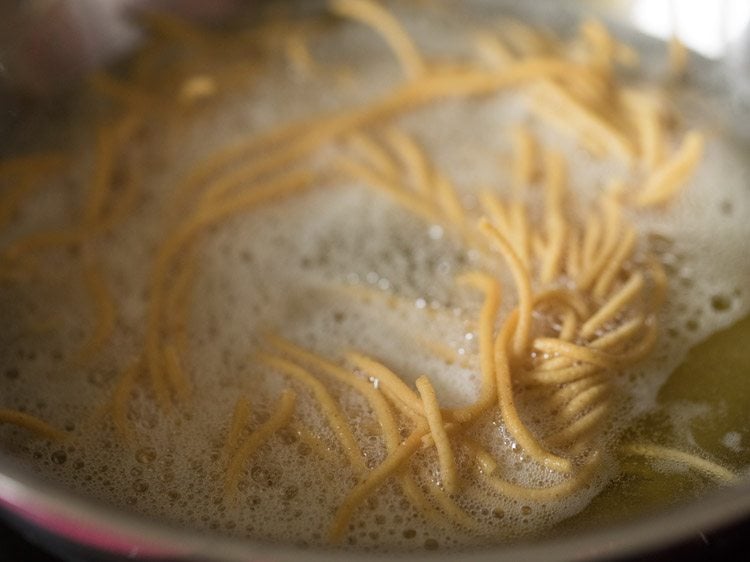
21. When the oil stops sizzling, continue to fry for some more seconds till the omapodi is golden and crisp. Turn over as needed, when frying.
Do not break omapodi while frying as then it becomes extra work to remove the small pieces from the oil. So, fry the entire round shaped omapodi as one piece and do not break it.
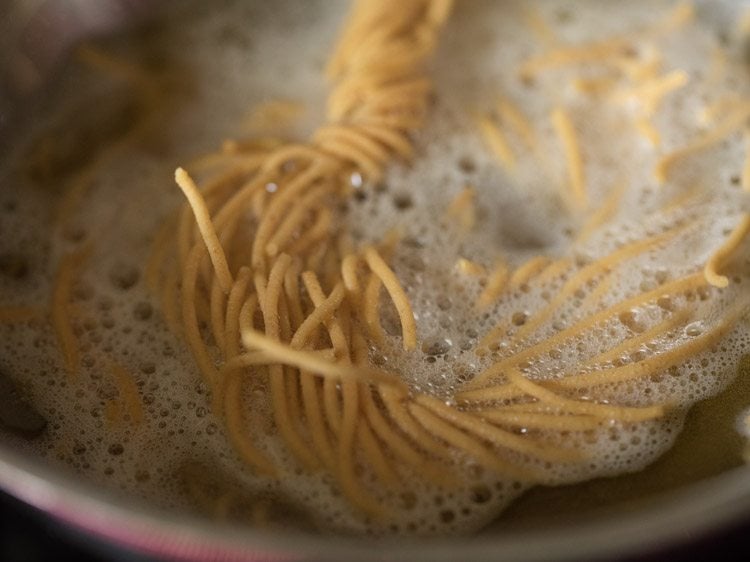
22. Once done, remove fried omapodi with a slotted spoon or a strainer spoon draining off the extra oil.
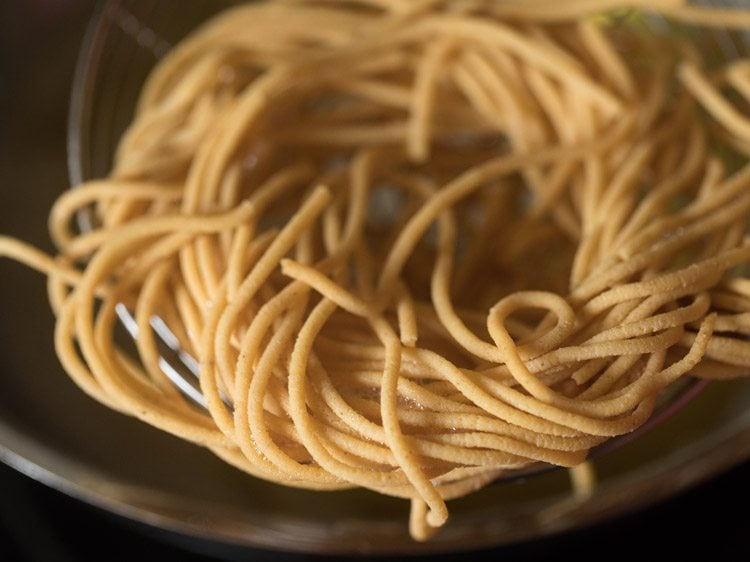
23. Place fried omapodi on kitchen paper towels. Fry remaining in the same way.

24. When omapodi cools, place in an air-tight container or box. Before adding to the Madras Mixture, break the omapodi.

Make Boondi Batter
25. Take ½ cup gram flour (besan) and 1 tablespoon rice flour in a mixing bowl.
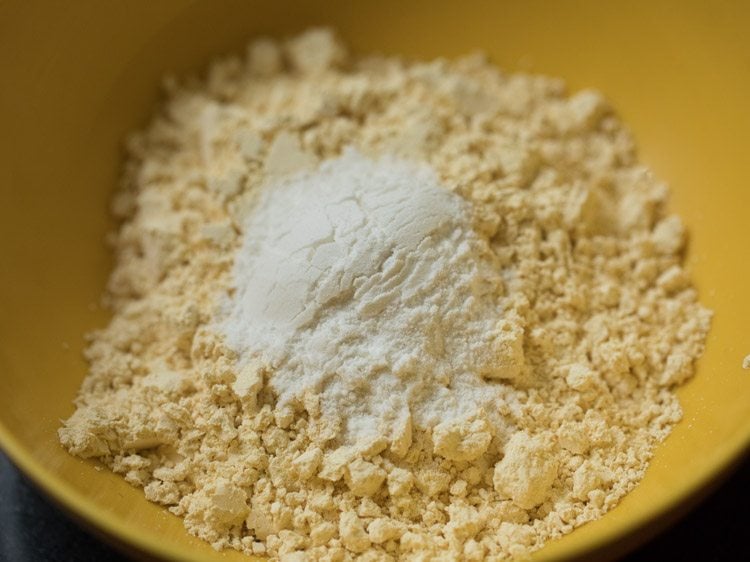
26. Then, add 1 pinch asafoetida (hing), 1 pinch baking soda, 2 pinches turmeric powder and ½ teaspoon salt.

27. Mix everything with a spoon.
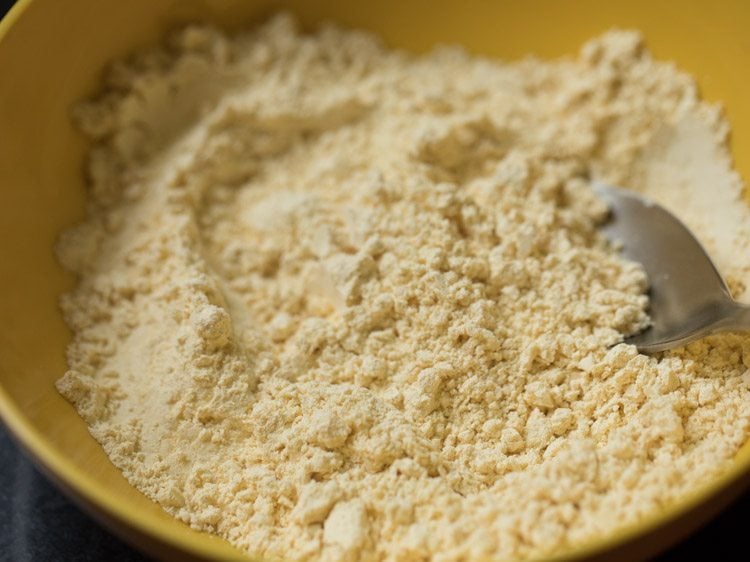
28. Now, add 8 to 9 tablespoons water in parts.

29. Using a wired whisk, make a smooth and slightly thin batter without lumps.
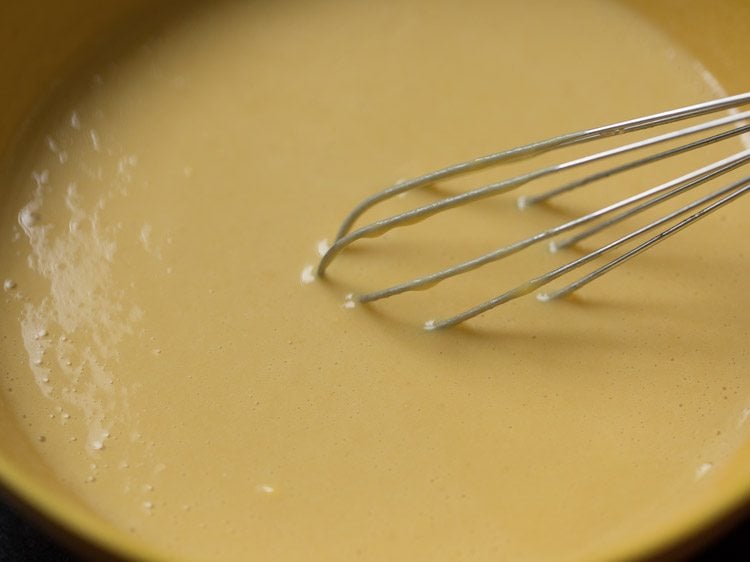
30. The batter consistency is slightly thin. The amount of water to be added depends on the quality of gram flour. So, add accordingly.
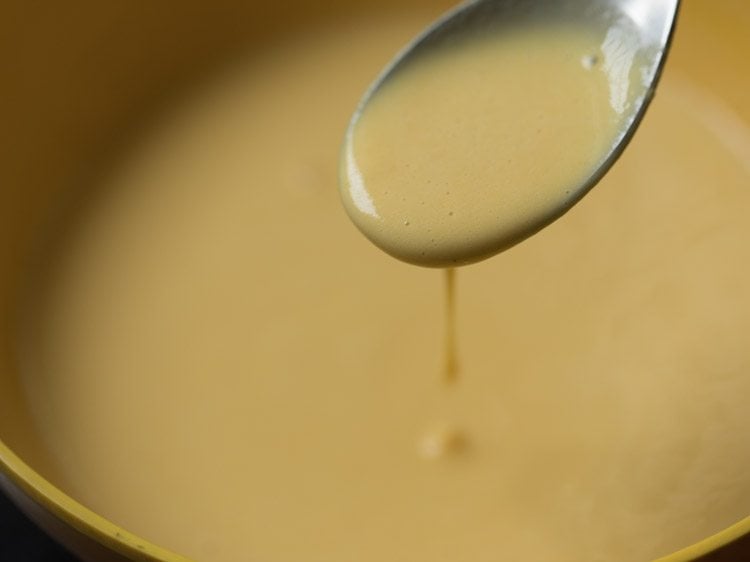
Fry Boondi
31. Heat oil for frying in a kadai or pan. When the oil becomes hot, then tap the wired whisk or the handle of a spoon which has a bit of batter in to the hot oil.
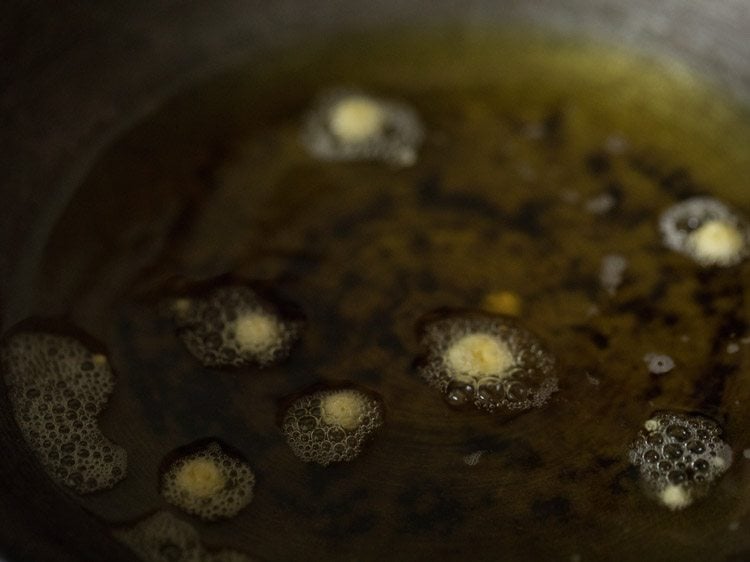
32. The boondi should have a round shape. When they become flat, then the batter is thin. If they get tail ends, then the batter is thick.
Tip: In case the batter is thin, then add 1 to 2 teaspoons gram flour and check by frying a few boondi.
Tip: If the batter is thick, then add a few teaspoons water and then do the same test. Once you get the correct consistency, proceed with the next step of frying the boondi.

33. Now, take a dry perforated ladle (jhara) and place it above the hot oil. Don’t keep at too much height, as the batter droplets, when falling from a height, do not give a round shape.
With a spoon, add some batter on the perforated ladle. Spread the batter lightly with a spoon. Finish up the batter on the perforated ladle this way.

34. On medium heat, begin to fry the boondi. Do not turn them. Let them become slightly crisp and then only turn them over.
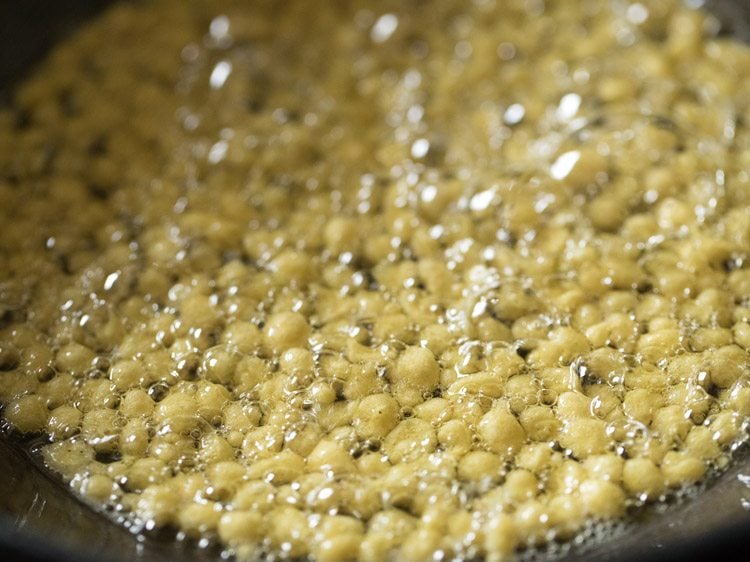
35. When the boondi has become crisp, turn with a slotted spoon. You won’t get perfect round shape for each boondi, but it does not matter as the taste of homemade boondi is better than store bought ones.
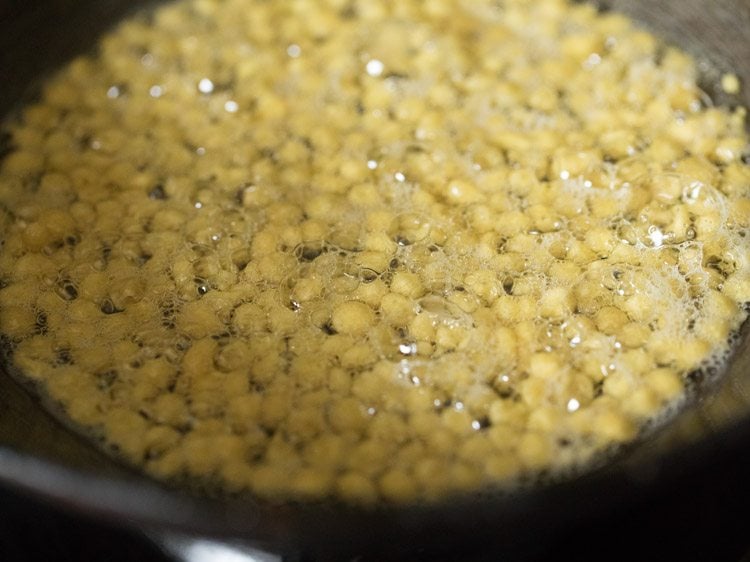
36. After the oil stops sizzling, continue to fry the boondi for some more seconds so that they become crisp
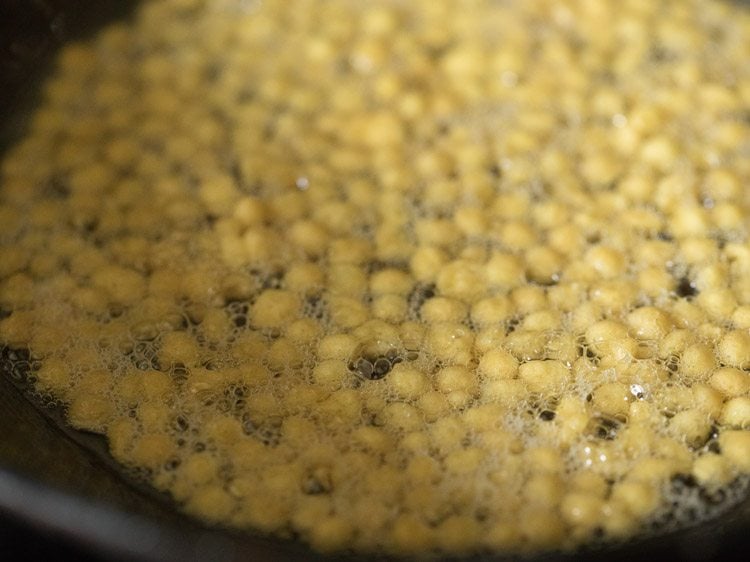
37. Remove with a strainer spoon or a slotted spoon draining the extra oil.

38. Place the fried boondi on kitchen paper towels.
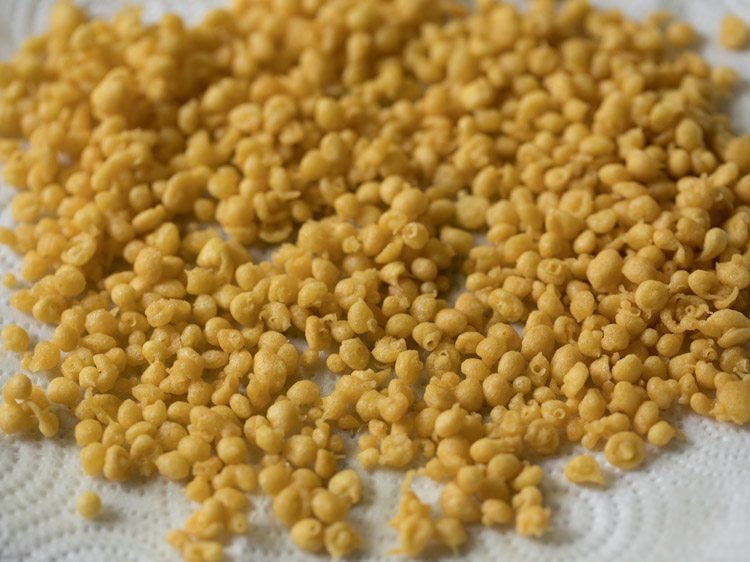
39. After each batch, wipe the perforated ladle with a clean piece of thin moist cotton kitchen towel from both sides. Continue to fry boondi this way. Once the boondi cools at room temperature, store in an air-tight jar or container.

40. While the boondi is getting fried, you can keep everything ready for the next step. Take 2 cups omapodi and 2 cups boondi.
The rest of the omapodi you can serve as snack. The remaining boondi can be used for making other boondi-based dishes.

Fry More Ingredients for Madras Mixture
41. Use a fine sieve ladle as shown in the picture below for frying. In Indian markets, we get these sieve with a handle.
This sieve ladle is very helpful for frying ingredients which have small pieces or flakes. As you don’t waste time and energy trying to find out the rice flakes or the chana dal in the oil.
Heat some oil for deep frying in a pan or kadai. You can also use the same oil in which you fried the boondi. Keep the heat to medium.

42. Take ¼ cup peanuts first in the sieve. Immerse in the oil and begin to fry on medium heat.

43. With a spoon, stir often while frying so that the peanuts are fried evenly.

44. Fry peanuts till they are crisp and crunchy.

45. Using the same sieve, drain the extra oil. So this ladle is helpful for frying as well as for getting rid of extra oil after frying.
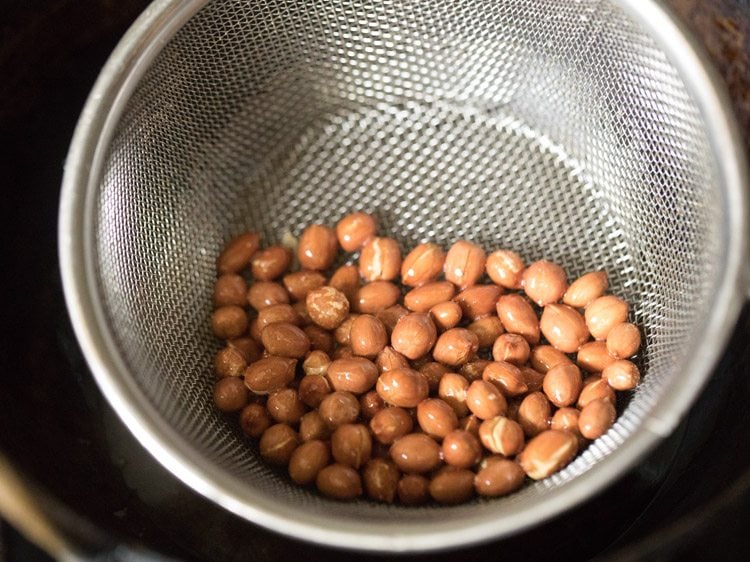
46. Place the fried peanuts on kitchen paper towel.

47. Then, take 25 cashews in the same ladle.
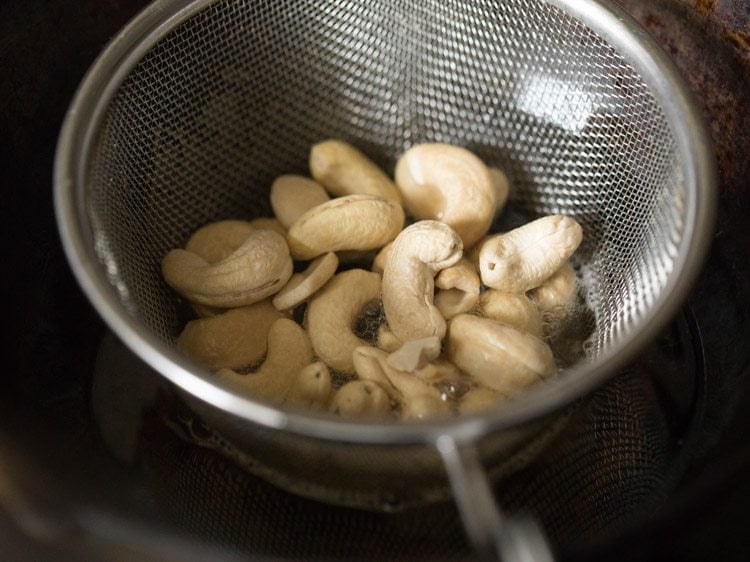
48. Stirring often with a spoon, fry cashews till golden.

49. Place the fried cashews on the same kitchen paper towel.

50. Next, take ¼ cup roasted Bengal gram (chana dal).

51. Stirring often with a spoon, fry roasted chana dal till crisp.
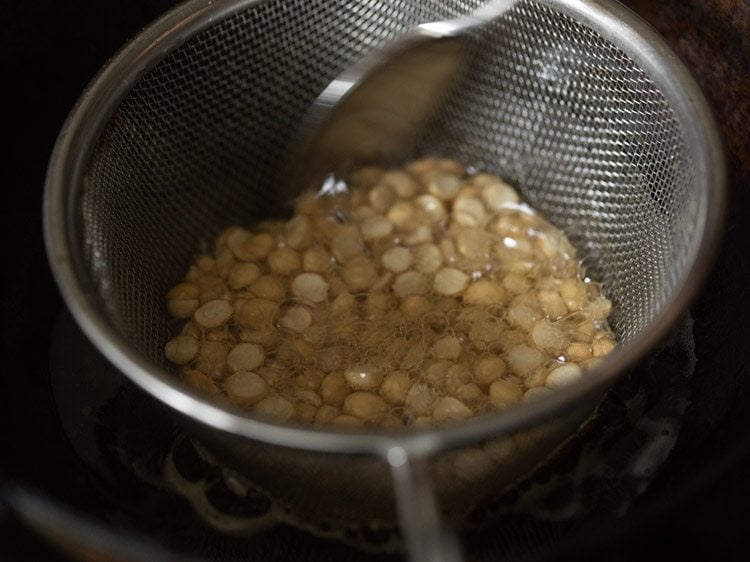
52. Frying chana dal will take some seconds and their color will change.

53. Place the fried chana dal on the same kitchen paper towel.

54. Now, take ¼ cup thick flattened/parched rice (poha). I have used thick poha. You can also use thin poha.
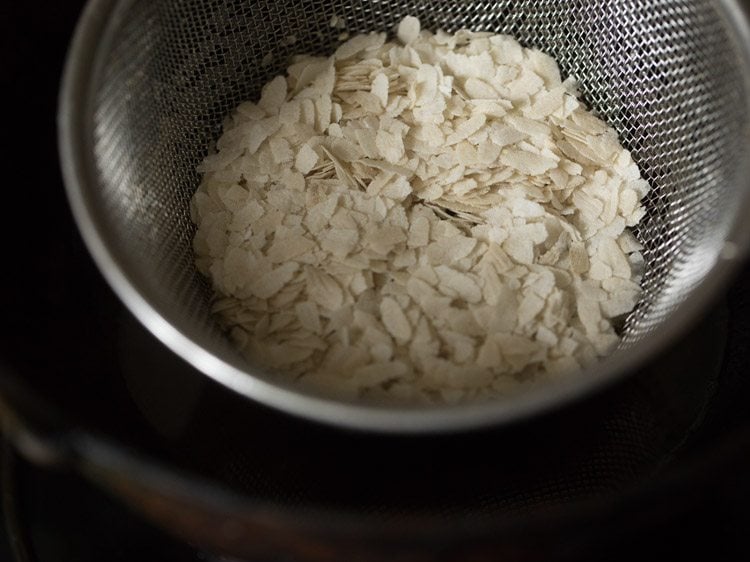
55. Stirring often with a spoon, fry the poha till crisp and pale golden. Don’t brown the poha.
You can add more poha if you want. You can also add more of peanuts, roasted chana dal or cashews, if you like.

56. Once the poha is fried well, drain off the extra oil using the same ladle.
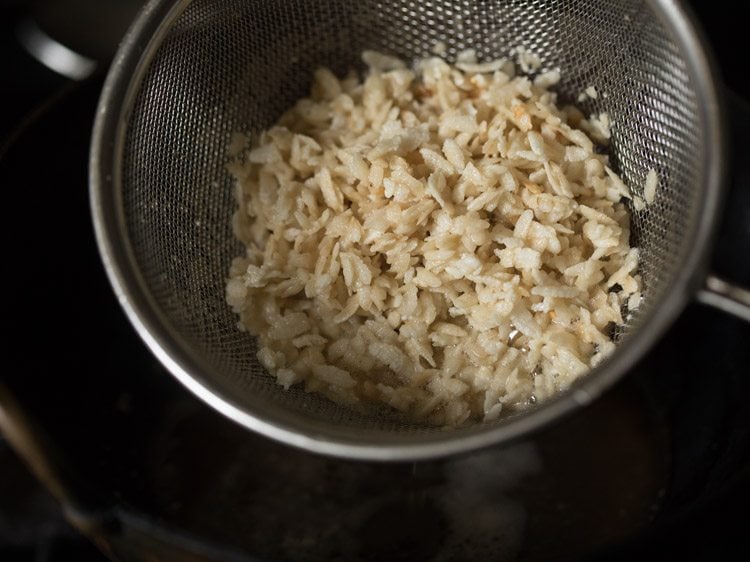
57. Place the fried poha on the same kitchen paper towel.
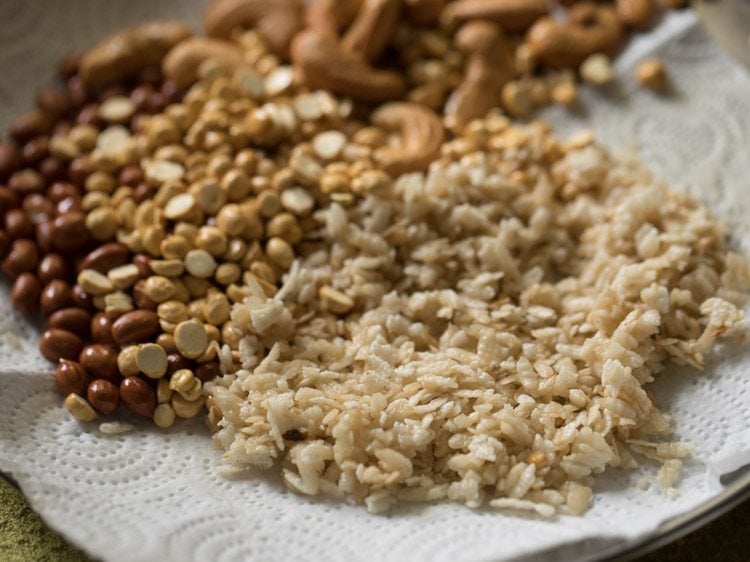
58. Next, add 12 to 15 curry leaves.
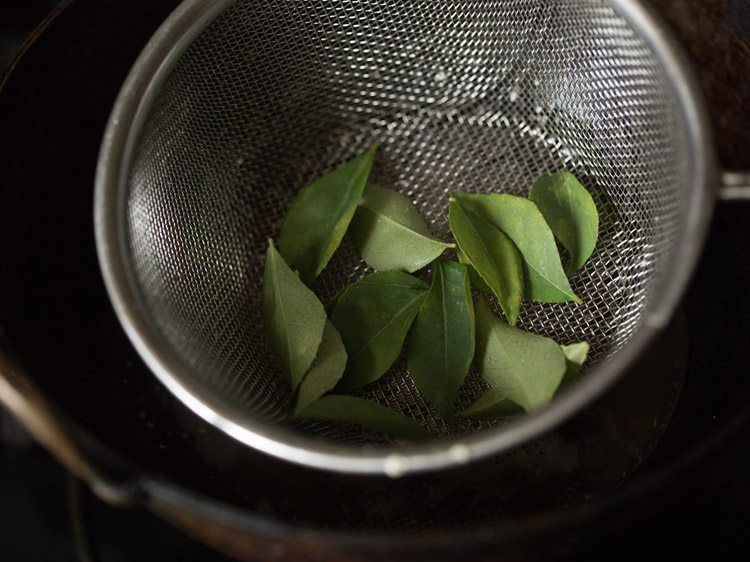
59. Stirring often, fry curry leaves till crisp.

60. Curry leaves take a few seconds to fry.
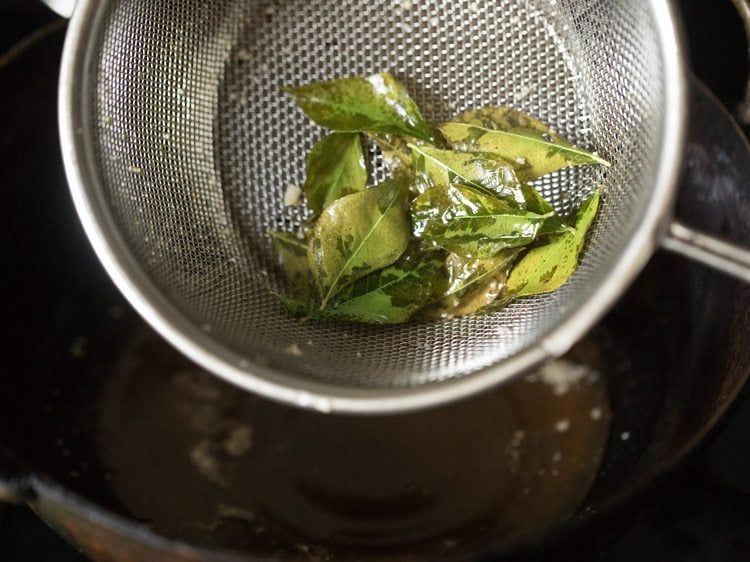
61. Place the fried curry leaves on the same kitchen paper towel.

Make South Indian Mixture
62. In a large bowl, tray or plate, take 2 cups omapodi and 2 cups boondi. Break omapodi before you begin to mix.
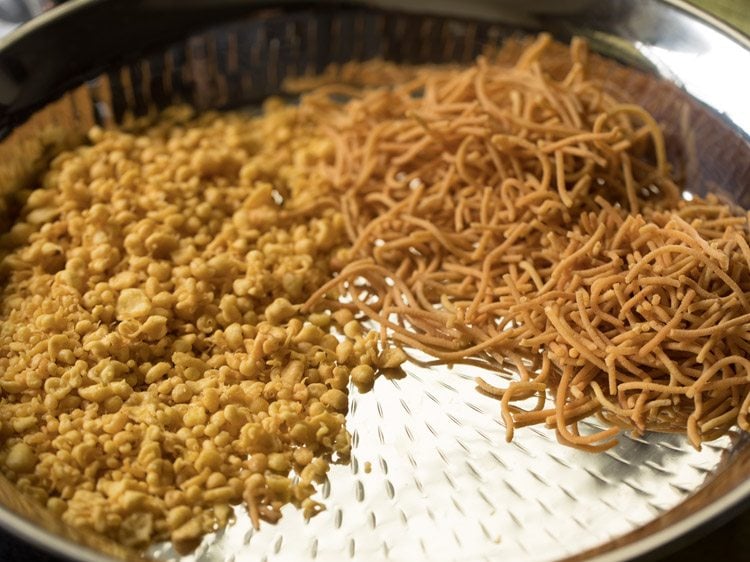
63. Add the fried cashews, poha, chana dal and curry leaves.

63. Add ½ teaspoon red chili powder, ⅛ teaspoon (2 pinches) asafoetida (hing) and salt as per taste over the fried chana dal, poha, nuts and curry leaves, as these will be still hot. You can also add some powdered sugar for a slight sweet taste.
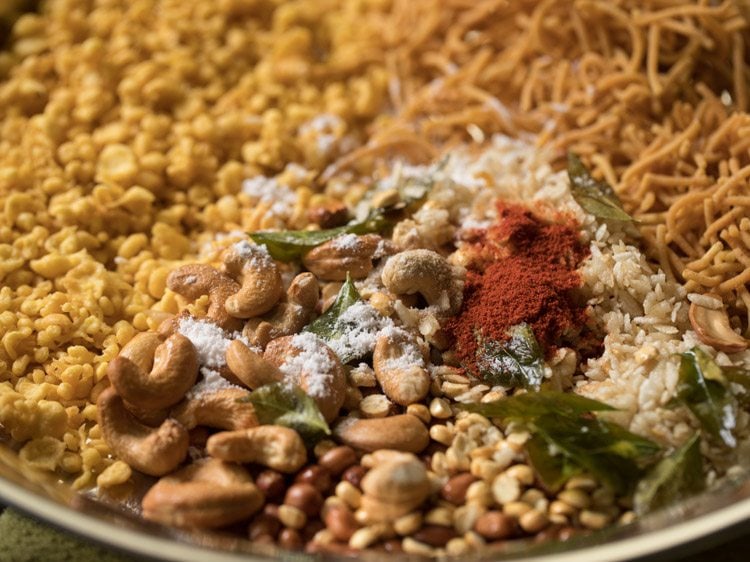
64. Mix well with a spoon first and then later you can mix with your hands.
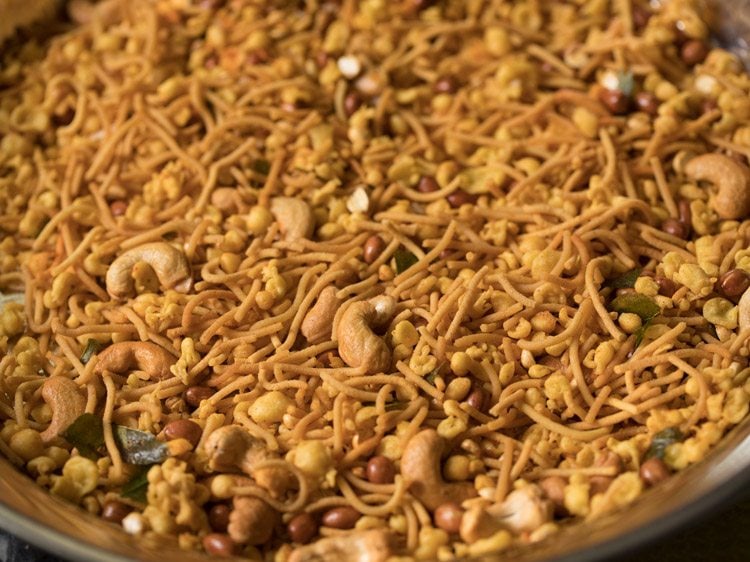
65. Then, place the Madras Mixture in an air-tight jar or container. Store at room temperature.
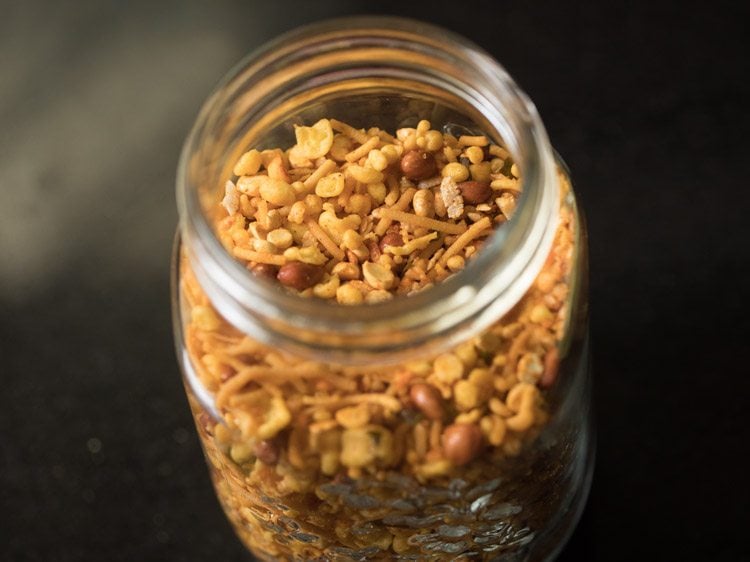
66. Serve South Indian Mixture as a Diwali or tea time snack.
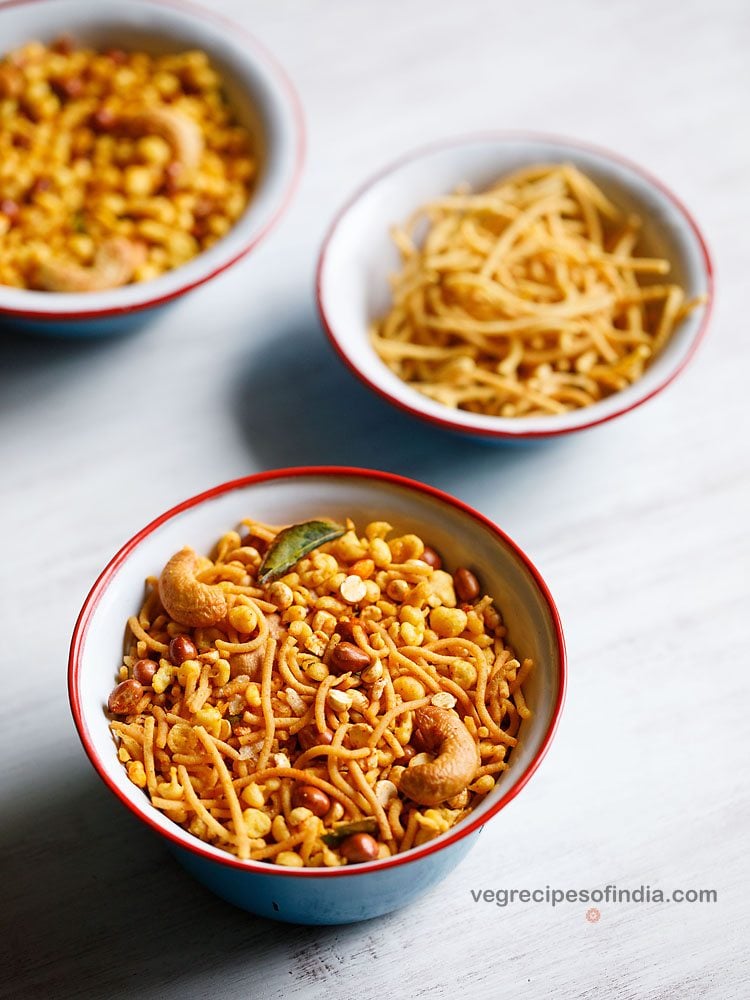
Expert Tips
- Instead of grinding the carom seeds for the omapodi, you can even crush in a mortar-pestle. If doing so, make sure to sift the ajwain powder using a tea strainer. This will prevent the dough from breaking when it is pressed through the sev maker.
- In the omapodi, the turmeric powder can be skipped. To make it spicier, add more red chili powder. to make it crispier, add a pinch of baking soda.
- Quantity of water to knead the omapodi dough will depend on the quality of gram flour and rice flour. If your dough becomes sticky, add more gram flour and knead. If dry, add more water and knead again. The final consistency of the dough should be smooth.
- The consistency of boondi batter should be slightly thin. Depending on the quality of gram flour, adjust the quantity of water.
- While frying the batter into boondi using a perforated spoon/ladle, make sure to not keep at too much height. As this way, the batter droplets will not have a round shape.
- It is better to use a fine sieve ladle, easily available in the market or online, for frying the ingredients. Using this helps you to not waste time and energy in finding out smaller pieces or flakes in the oil.
- You can use either use thick poha or thin poha for this recipe. You can even increase the quantity of poha along with more peanuts, cashews and chana dal.
- Some powdered sugar can be added to the fried ingredients while mixing. This is, if you like a slightly sweet taste in your Madras Mixture.
More Diwali Snacks Recipes To Try!
Eggless Cookies & Biscuits
Sweets Recipes
Evening Snacks
Evening Snacks
Please be sure to rate the recipe in the recipe card or leave a comment below if you have made it. For more vegetarian inspirations, Sign Up for my emails or follow me on Instagram, Youtube, Facebook, Pinterest or Twitter.

Mixture Recipe | Madras Mixture
Ingredients
For omapodi
- 1 teaspoon carom seeds (ajwain, omam)
- 1 cup gram flour (besan) – 120 grams
- ½ cup Rice Flour or 100 grams
- 1 generous pinch asafoetida (hing)
- 2 pinches turmeric powder – optional
- ¼ teaspoon red chilli powder
- 1 teaspoon salt or add as required
- 1 tablespoon oil or ghee or butter
- 6 to 7 tablespoons water or add as required
- oil as required for deep frying
For kara boondi
- ½ cup gram flour (besan)
- 1 tablespoon Rice Flour
- 1 pinch asafoetida (hing)
- ½ teaspoon salt or as required
- 8 to 9 tablespoons water to make thin batter
- oil for deep frying, as required
Other ingredients
- ¼ cup peanuts
- 25 cashews
- ¼ cup roasted chana dal (roasted bengal gram)
- ¼ cup poha (flattened rice or parched rice)
- 12 to 15 curry leaves
- ⅛ teaspoon asafoetida (hing) or about 2 pinches
- ½ teaspoon red chilli powder
- 2 cups omapodi or add as required
- 2 cups boondi or add as required
- salt as required
Instructions
Making omapodi
Preparing omapodi dough
- Heat a small pan and keep flame to a low. Add 1 teaspoon ajwain (carom seeds).
- Stirring often roast ajwain for some seconds till they are aromatic. No need to brown them. Let them cool down.
- Then add them in a small dry grinder jar or a spice grinder.
- Grind to a fine powder. Keep aside. You can even crush ajwain in a mortar-pestle. In this case, when adding ajwain, use a tea strainer and sift the ajwain powder through it. This is done so that when pressing through the sev maker, the dough strands do not break.
- In a mixing bowl or pan take 1 cup besan (gram flour) and ½ cup rice flour.
- Add the ground ajwain powder.
- Then add 1 generous pinch asafoetida (hing), 2 pinches turmeric powder, ¼ teaspoon red chilli powder and 1 teaspoon salt. You can add salt as per taste. Turmeric powder can be skipped. For a spicy omapodi, you can increase the amount of red chilli powder. For more crispiness you can add a pinch of baking soda also.
- Mix very well with a spoon or spatula.
- Now heat 1 tablespoon oil in a steel bowl or a steel measuring cup.
- When the oil becomes hot, add it to the flour mixture. Instead of oil you can also use ghee or butter.
- Now add water in parts. First add 2 to 3 tablespoons of water. Mix well and begin to knead to a smooth dough. Overall I used 7 tablespoons of water. You can add 6 to 7 tablespoons of water depending on the quality of besan and rice flour.
- Knead to a smooth dough. If the dough becomes sticky, then you can add some more besan. If the dough looks dry, then add some more water and knead again. Cover the bowl and set aside.
- Use the disc to make sev or omapodi and assemble the sev press or murukku press. You can even use the disc with fine holes. Also heat a kadai and add oil as required for deep frying omapodi.
- Apply some water or oil in the sev/murukku maker. Then take a portion of the omapodi dough and place it inside the sev maker. Cover with the top part and keep aside.
Frying omapodi
- Let the oil in the kadai become medium hot. Check the oil temperature by adding a small tiny piece of the omapodi dough. If the small piece of dough comes up gradually and steadily on top, the oil is hot enough to fry. If it comes up too quickly, then oil is too hot. If it settles down at bottom of kadai or comes up very slowly, the oil is not hot enough for frying.
- When the oil is hot enough, directly press holding the sev maker on top of the oil and let the sev directly fall in the oil. While pressing rotate in a concentric circle from the center to outwards similar to making a chakli. Do not over crowd the kadai with omapodi. Add as much as needed without overcrowding the kadai. Be careful when pressing the dough in the oil. After the omapodi is pressed in the oil, break the top strands with a spoon or knife and let the dough strands fall in the oil.
- After adding the omapodi, do not touch them immediately with the slotted spoon as they break. Let them get fried first for a minute. They need to become crisp first and then you can turn them over with the slotted spoon.
- Gently begin to turn with a slotted spoon.
- Now fry the second side. You can turn over a couple of times for even frying.
- When the oil stops sizzling, continue to fry for some more seconds till the omapodi are golden and crisp. Turn over as needed when frying. Do not break the omapodi while frying as then it becomes extra work to remove the small pieces of omapodi from the oil. So fry the entire round shaped omapodi as one piece and do not break it.
- Once done then remove omapodi with a slotted spoon or a strainer spoon draining off the extra oil.
- Place them on kitchen paper towels. Fry the remaining omapodi in the same way.
- When the omapodi are cooled, then place them in an air tight container or box. Break omapodi before adding in the mixture.
Making Boondi
Preparing boondi batter
- Take ½ cup besan (gram flour) and 1 tablespoon rice flour in a mixing bowl.
- Then add 1 pinch asafoetida (hing), 1 pinch of baking soda, 2 pinches turmeric powder and ½ teaspoon salt.
- Mix everything with a spoon.
- Now add 8 to 9 tablespoons water in parts.
- Using a wired whisk make a smooth and slightly thin batter without lumps.
- The batter consistency is slightly thin. The amount of water to be added depends on the quality of gram flour. So add accordingly.
frying boondi
- Heat oil for frying in a kadai or pan. When the oil becomes hot, then tap the wired whisk or the handle of a spoon which has a bit of batter in to the hot oil.
- Now take a dry perforated ladle/jhara and place it above the hot oil. Don't keep too much on a height, as the batter droplets, when falling from a height, do not give a round shape. With a spoon add some batter on the perforated spoon ladle/jhara. Spread the batter lightly with a spoon. Finish up the batter on the perforated spoon ladle this way.
- On a medium flame heat to fry the boondi. Do not turn them. Let them become slightly crisp and then turn them.
- When the boondi have become crisp, turn them with a slotted spoon.
- After the oil stops sizzling, continue to fry the boondi for some more seconds so that they become crisp.
- Remove with a strainer spoon or a slotted spoon draining the extra oil.
- Place the fried salted boondi on kitchen paper towels.
- After each batch, wipe the perforated ladle/jhara with a clean piece of moist thin cotton kitchen towel from both sides. Continue to fry boondi this way. Once the boondi cools at room temparature, store in an air tight jar or box.
- When the boondi are frying you can remove the other ingredients and keep everything ready for the next step.
Frying nuts
- Use a fine sieve ladle with a handle to fry as shown in the stepwise photos in the post. Heat oil on medium heat.
- Take the peanuts first in the sieve. Immerse in the oil and begin to fry.
- With a spoon stir often while frying so that the peanuts are fried evenly.
- Fry peanuts till they are crisp and crunchy.
- Using the same seive drain the extra oil. So this ladle is helpful for frying as well as for getting rid of extra oil after frying.
- Place the fried peanuts on kitchen paper towel.
- Then take cashews in the same ladle.
- Stirring often with a spoon fry cashews till they are golden.
- Place the fried cashews on the same kitchen paper towel.
- Next take roasted chana dal.
- Stirring often with a spoon fry roasted chana dal till they are crisp.
- Frying chana dal will take some seconds and their color will change.
- Place the fried chana dal on the same kitchen paper towel.
- Now take thick poha.
- Stirring often with a spoon fry poha till they are crisp and pale golden. Don't brown the poha.
- Once the poha is fried well, then drain off the extra oil using the same ladle.
- Place the fried poha on the same kitchen paper towel.
- Next add curry leaves. stirring often fry curry leaves till they become crisp.
- Curry leaves take a few seconds to fry. Place the fried curry leaves on the kitchen paper towel.
Making Madras Mixture
- In a large bowl or tray or plate take 2 cups of the omapodi and 2 cups of fried boondi. The remaining omapodi you can serve as a snack. With the remaining boondi, you can make boondi raita. You can also take more of the omapodi or boondi if you prefer.
- Add the fried nuts, poha, chana dal, curry leaves.
- Add ½ teaspoon red chilli powder, ⅛ teaspoon asafoetida (hing) and salt over the fried chana dal, poha, nuts and curry leaves as they will be still hot.
- Mix well with a spoon first and then later you can mix with your hands.
- Then place the mixture in a jar or container. Store at room temperature.
- Serve South Indian Mixture as a diwali snack or a tea time snack.
Notes
- Fry the boondi and omapodi and the remaining ingredients in moderately hot oil.
- Add more red chilli powder in the omapodi dough for a spicier omapodi. You could also use green chili paste instead of red chilli powder.
- Skip asafoetida for a gluten-free variation.
- Note that the approximate nutrition info is for 1 serving.
Nutrition Info (Approximate Values)
This Mixture Recipe from the archives first published in October 2017 has been updated and republished on 21 October 2022.
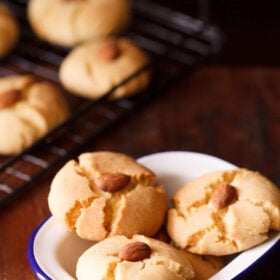
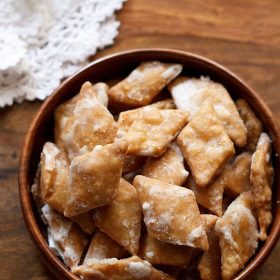
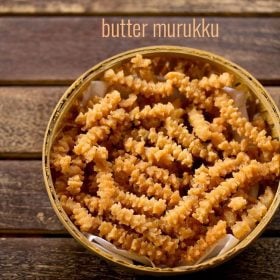
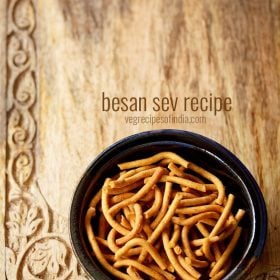













Hi, you have mentioned 120g or 1 cup of besan flour and 100g or 1/2 cup of rice flour. Can’t understand how 1/2 of 120 is 100. So the cup varies and measurement is right Please clarify my doubts. I always have confusion in measurement.
Liquids are measured in ml and so the cup measure will be correct one for liquids. eg 1 cup of milk or 1 cup of water or orange juice will always be of the cup size used like 200 ml or 250 ml. But with solid ingredients, it is not the same. Here, the density of the ingredients come into play. So 1 cup rice flour is not 250 grams and 1 cup of besan is not 250 grams of besan. 1 cup rice flour when measured on a weighing scale will weigh 200 grams and 1 cup of besan on a weighing scale will weigh 120 grams. So for solid ingredients the measurements is different. Either you can follow the cup measurement or the weight (metric measurement). I hope this helps.